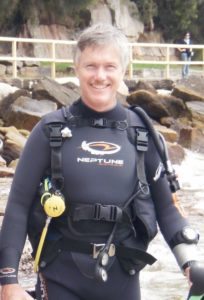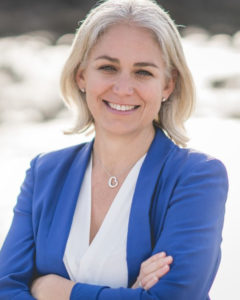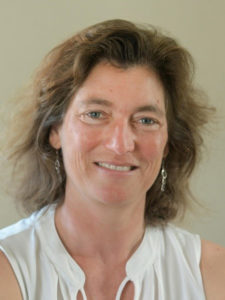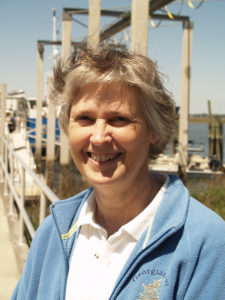 Dr. Iain Suthers
Dr. Iain Suthers
School of Biological, Earth & Environmental Sciences
University of New South Wales & Sydney Institute of Marine Science (SIMS)
Dr. Suthers was the inaugural chair of the NSW-IMOS (NSW-Integrated Marine Observing System) from 2007-2012. He now leads the IMOS Larval Fish Monitoring subfacility – coordinating monthly ichthyoplankton sampling off Brisbane, Sydney, Hobart, Adelaide, Perth.
He completed his PhD in Canada and post-doctoral work in Norway and Australia before taking up a lectureship at UNSW in 1991. Since then he has conducted 14 research voyages off eastern Australia, sampled the plankton of dozens of estuaries with local and state government agencies on projects from red tides to larval fish ecology, fish age and growth, eutrophication, stock enhancement of estuaries and marine food webs. His recent research concerns frontal eddies of the East Australian Current, plankton particle size, and the fisheries of offshore artificial reefs based on the supply of zooplankton (which sustains the Great Southern Reef of Australia).
The biological consequences of eddies, entrainment and coastal connectivity of the EAC
The East Australian Current (EAC) drives the biological connectivity and the tropicalisation of temperate coastal ecosystems, affecting the $10 billion pa “blue economy” for more than half the Australian population. The EAC has two distinguishing characteristics which have biological consequences. Firstly, over its length from 20 to 40°S, the EAC interacts with a narrow shelf only 15 to 40 km wide, which drives uplift and forms productive, cool, saline inner-shelf water around rocky reef ecosystems. This may generate the distinctive biomass of zooplankton and planktivorous fish at the mid latitudes (30-36°S) which we have recently identified, and which likely occurs on other temperate coasts worldwide.
Secondly, where the EAC separates from the coast and forms the retroflection, it creates and sheds eddies in a small region we have termed “Eddy Avenue”. Approximately half of the EAC flow continues south along the continental slope towards Tasmania (the EAC extension) as a poleward moving train of eddies. By using a stable isotopes and size-based approach, we found the upwelling favorable cyclonic eddies are characterized by shorter but less efficient planktonic food chains (dominated by herbivores), compared to longer more efficient planktonic food chains in oligotrophic anticyclonic eddies (dominated by carnivores).
 Dr. Moninya Roughan
Dr. Moninya Roughan
Chief Scientist
MetOcean Solutions
Professor, University of New South Wales and IMOS group leader
As a physical oceanographer specializing in coastal and shelf processes, Moninya’s research focuses on improving dynamical understanding of coastal ocean circulation. She has substantial experience using a combination of ocean observations and numerical models, and has authored over 100 publications including peer-reviewed journal papers, book chapters, international conference papers, consultancy and technical reports. Prof. Roughan gained her PhD in Physical Oceanography from UNSW Australia (2002), and spent 4 years at Scripps Institution of Oceanography as a postdoctoral scholar (2002-2006) before returning to UNSW in 2006. She spent 2 years in Industry as Head of Research Partnerships at the NZ Meteorological Service 2017-2019 and returned to UNSW full time in 2020 as a Professor of Oceanography.
Over the past 10 years, she has led the design, deployment and ongoing development of one of the most comprehensive ocean observing systems in the southern hemisphere. Focused on the East Australian Current, Prof. Roughan and her IMOS team have deployed a network of moorings, HF radar, autonomous ocean gliders and floats along the coast of southeastern Australia to investigate the East Australian Current System, and the impact of the current on the continental shelf hydrodynamics along Australia’s most populous coastline. At UNSW, Prof Roughan leads a team of PhD students, postdocs and field technicians doing active research. Together they successfully completed 100s of mooring deployments and nearly 50 autonomous glider missions. She has conducted fieldwork from Antarctica to Torres Strait, spending more than 100 days at sea on large and small research vessels.
Shelf Ocean Exchange in the East Australian Current System
The East Australian Current (EAC) transports heat, mass and biota poleward, along Australia’s most populous coastline from ~27 – 44 S where societal impacts are greatest. It flows poleward to ~32 S where it separates and sheds large mesoscale anticyclonic eddies. Flow continues poleward in the EAC southern extension as an eddy train.
Over the past decade through Australia’s Integrated Marine Observing System (IMOS) we have deployed a range of modern technologies to observe the length and breadth of the EAC System. These state-of-the-art observations include High Frequency coastal radar, autonomous underwater gliders, and a network of coastal and deep water moorings. The data from which are freely available. Combined with data assimilating models the data are have shed insight into a range of processes including ocean-shelf exchange.
Upstream of the EAC separation region continental shelf circulation is dominated by the EAC jet. HF radar observations show that the EAC transport and eddy kinetic energy variability strengthen in summer. However this is often masked by the mesoscale variability associated with the meandering of the jet at the 65-100 day timescales (also the eddy shedding timescale). EAC intrusions over the narrow shelf drive upwelling and the strength of the intrusions on the shelf vary with latitude and advective acceleration. Surface divergence is generated where the EAC deviates from the coast, which also leads to quasi-permanent upwelling. These processes are in addition to cross-shelf exchange by wind driven upwelling and downwelling.
Submesoscale cyclonic ‘frontal eddies’ form on the inside edge of the EAC which can grow to large cyclonic eddies, as they are advected poleward. These frontal eddies drive cross-shelf exchange through the entrainment of coastal waters and advection offshore. With retention of shelf larval fish populations they are shown to be disproportionately productive.
Downstream of the EAC separation region cross-shelf exchange is driven by the mesoscale eddy field. At ~33S onshore flow is a maximum driven by a quasi-steady eddy dipole associated with jet separation. Mesoscale EAC eddies have been shown to either retain or leak water depending on their eccentricity, contributing to watermass exchange.
The EAC is an ocean warming hotspot, with regular marine heatwaves. New results show that there is latitudinal gradient in warming driven by an increase in eddy kinetic energy downstream of the EAC separation.
All of these processes have biogeochemical consequences in what is an oligotrophic western boundary current system.
 Dr. Eileen E. Hofmann
Dr. Eileen E. Hofmann
Professor of Oceanography
Ph.D., M.S., North Carolina State University (1980, 1976)
B.S., Chestnut Hill College (1974)
From 2010-2015, Eileen Hofmann served as Chair of the Integrated Marine Biogeochemistry and Ecosystem Research (IMBER) project and she oversaw the development of new ten-year IMBER Science Plan and Implementation Strategy. Prior to IMBER she was a member of the international and U.S. science steering committees for the Global Ocean Ecosystem Dynamics program. She coordinated the U.S. and international Southern Ocean GLOBEC field programs and synthesis phases and participated in the U.S. Southern Ocean GLOBEC cruises to the west Antarctic Peninsula shelf. She is a member of the science steering committee for the Southern Ocean Observing System and is Past President of the Ocean Sciences section of the American Geophysical Union. She is Co-editor in Chief for the Journal of Marine Systems.
She co-edited the book, Foundations for Ecological Research West of the Antarctic Peninsula, which is part of the American Geophysical Union, Antarctic Research Series. She is co-editor of the GLOBEC synthesis book, Marine Ecosystems and Global Change. She is co-editor of three special issues of Deep-Sea Research II on results of the Southern Ocean GLOBEC program, two special issues of Progress in Oceanography on synthesis of GLOBEC program results and end-to-end ecosystem models, a special issue of Current Opinion in Environmental Sustainability on marine and aquatic systems, a special issue of Journal of Marine Research on oyster disease research and a special issue of Philosophical Transactions of the Royal Society B on marine diseases.
Research Interests
Dr. Hofmann’s research interests are in the areas of physical-biological interactions in marine ecosystems, environmental control and transmission of marine diseases, descriptive physical oceanography, and mathematical modeling of marine ecosystems. She has worked in a variety of marine environments, most recently the continental shelf region of the Ross Sea and the western Antarctic Peninsula, Chesapeake Bay and Delaware Bay, and the Middle Atlantic Bight off the east coast of the United States. Her contributions to modeling physical-biological interactions in marine systems were recognized by her election as a Fellow of the American Geophysical Union.
Modeling Western Boundary Currents and Ecosystem Interactions: Approaches and Challenges
The integrated modeling frameworks developed for continental shelf systems influenced by western boundary currents have focused primarily on understanding the fate and transport of carbon and nutrients. These studies have shown the importance of the land-estuary-shelf continuum, resolving seasonal and annual variability in fluxes, and understanding complex biogeochemical nteractions. However, reliable projections of the impacts of past and future change on these shelf ecosystems require fundamental understanding of the factors that determine the structure
and function of the food webs at multiple scales and approaches for incorporating this understanding into coupled modeling frameworks. This presentation will provide an overview of the current status of
integrated models developed for WBC shelf ecosystems and highlight challenges of incorporating into these models the effects of climate change and interactions. The South Atlantic Bight, which is influenced by the Gulf Stream, will provide a basis for comparing with other WBC-influenced continental shelf systems. The approaches associated with projecting the effects of climate change on nutrient and carbon cycling and the challenges associated with including socio-economic effects of changes in nutrient and carbon cycling for continental shelf systems will be highlighted.
 Dr. Frederico Brandini
Dr. Frederico Brandini
Department of Biological Oceanography
University of Sao Paulo, Brazil
Graduated in Biological Sciences from the Institute of Biosciences of the University of São Paulo (1976), Master in Biological Oceanography from Tokyo University of Fisheries (1981) and PhD in Biological Oceanography from the Oceanographic Institute of the University of São Paulo (1986). Post-doctorate at the Alfred-Wegener Institute (Germany) as a fellow at the Humboldt Foundation (1991-1992). He was Assistant Associate Professor at the Center for Marine Studies at the Federal University of Paraná (1981-2008), from which he received the title of Professor Emeritus (2009). He is currently Full Professor at the Oceanographic Institute of the University of São Paulo. He has experience in the area of Biological Oceanography, with an emphasis on Planktonology and Primary Phytoplankton Production. He published several articles on primary production and population dynamics of planktonic communities in coastal and continental shelf environments in southern Brazil and in oceanic regions of the South-West Atlantic and Antarctica. Recent studies involve the formation and ecological role of subsurface chlorophyll maximums in the Southeast-South Region of Brazil. The main extension projects involve the implantation of artificial reefs on the platform of the State of Paraná in order to protect marine biodiversity and support artisanal fishing.
Biogeochemical patterns and ecosystem response to physical drivers in the South Brazil Bight
The South Brazil Bight (23°S-28.5°S) and the Southern Shelf (28.5°S-34°S) are the two southernmost provinces of the Brazilian margin that occupy most of the subtropical Western Boundary System in the Southwestern Atlantic Ocean, where complex hydrography and circulation patterns take place due to shelf morphology, climatological forces and the Brazil Current (BC) flow. Three distinct cross-shelf sections are identified based on bathymetry and physical drivers of circulation: (i) the inner-shelf (<50m), where currents are drifted northwards by baroclinic pressure gradient forces; (ii) the middle shelf (50-100m), where circulation is mostly wind-driven; and (iii) the outer shelf, were currents are directly associated with the Brazil Current flow. The water masses that occupy these two provinces are the low saline nutrient-rich Coastal-Shelf Water, the offshore warm and nutrient-poor Tropical Water of the BC, and the deep oceanic and nutrient-rich South Atlantic Central Water (SACW). Each one of them has specific environmental limitations to biogeochemical processes, particularly phytoplankton primary production. Except for coastal upwelling in short summer periods and the alongshore continental runoff, the overall oligotrophy of the mid- and outer-shelf regions is kept by the dominance of nutrient-poor tropical waters transported by the BC. Primary production rates are usually <0.2 mgC m-2 d-1 in the offshore regions typical of a regenerative system, usually dominated by pico-sized cyanobacteria of the genera Synechococcus and Prochlorococcus with a minor contribution of pico- and nano-sized eukaryotes. A mean of 0.5 mgC.m-2 d-1 is the usual rate over the shelf. However, new production may be enhanced along the boundaries between water masses, including tidal, upwelling, and estuarine fronts; In the summertime, onshore intrusions of the SACW fertilizes the lower half of the euphotic zone in the middle-shelf reaching peak productivity rates of 3-4 mgC m-2 d-1 due to deep chlorophyll maximum layers (DCML) between 5-10% surface light. Diatoms tend to dominate the carbon biomass in this subsurface layer of net production, enhancing the export of particulate organic matter to benthic ecosystems. In the outer shelf sections, DCML occurs deeper in the euphotic zone (1-5% surface solar radiation) triggered by cyclonic eddies and meanders of the BC. In wintertime, the southwestern inner- and middle-shelf sections are invaded by Subtropical Shelf Front (SSF) formed by the lateral advection of the La Plata River plume. This front brings large amounts of nitrate, phosphate, and silicate, changing remarkably the chemical and biological scenario of the southernmost shelf. Higher surface concentrations of chlorophyll can be seen each year in satellite images. Large amounts of phosphorus not efficiently used by micro-sized phytoplankton, and presumable iron, may support diazotrophs, particularly the massive blooms of Trichodesmium usually observed even in nearshore waters. Despite decades of field studies many gaps in knowledge still need to be covered to better understand the structure and the functioning of the shelf system and its interaction with the BC.
 Dr. Ilson Carlos Almeida Da Silveira
Dr. Ilson Carlos Almeida Da Silveira
Department of Physical, Chemical and Geological Oceanography
University of Sao Paulo, Brazil
BA in Oceanography from the State University of Rio de Janeiro (1984), Master in Oceanography (Physical Oceanography) from the University of São Paulo (1990) and Ph.D. in Earth Sciences – Physical Oceanography from the University of New Hampshire (1996) . He has a post-doctorate in Physical Oceanography from the University of Rhode Island (1996-1997). He is currently Full Professor in Physical Oceanography at the Oceanographic Institute of the University of São Paulo (IOUSP). Its main activity is in mesoscale dynamics associated with western boundary currents, with an emphasis on studies of geophysical instability and vortex formation. Develops research in experimental, theoretical and numerical dynamic oceanography.
The Brazil Current Revisited
The Brazil Current (BC) is probably the least known and explored of all subtropical western boundary currents of the global ocean. In this talk, we will ride the BC from its origin site at 14oS to the region where it collides with the Malvinas Current, i.e., the Brazil-Malvinas Confluence at about 38oS. We will address how and why the BC is affected by the Atlantic Meridional Overturning Circulation (AMOC) causing it to thicken poleward. The BC starts a barely 200-m flow carrying only 2 Sv (1 Sv=106 m3 s-1) of Tropical Water (TW) towards the south. In its way to more subtropical latitudes, the BC contours several coastal banks and small bights, which yields the formation of large, semi-permanent anticyclonic meanders. At 20.5o S, the BC is forced to detach from the continental margin and cross the Vitória-Trindade Ridge. This quasi-zonal seamount chain divides the pycnocline-intensified branch of the South Equatorial Current (SEC). This bifurcation feeds the BC that thickens, strengthens, and surpasses the chain through a large cyclonic loop which may fold to form a detached cyclone, known as the Vitoria Eddy. Between 21o S to 26o S, the Intermediate Western Boundary Current (IWBC) flows equatorward underneath the BC. The two opposing oceanic jets have about the same volume transport of 6-8 Sv with virtually no barotropic component. The BC-IWBC system then develops quasi-stationary unstable cyclonic meanders around Cape São Tomé (22oS) and Cape Frio (23oS), which play an important role in the local processes of shelf-deep ocean exchanges. In the five-degree latitude range cited above, the BC transports TW and the South Atlantic Central Water (SACW), and occupies about the upper 500 m of the water column. South of 30oS, the BC is fully formed and has added the contribution of the intermediate SEC at about 28oS. However, in the southernmost portion of its pathway, the BC volume transport does not only increase by the stacking of water masses from below. It also increases its transport due to a tight recirculation cell of Sverdrupian nature. The fact is that the BC separates from the continental margin as a 35 Sv current with a vertical extension of more than 1500 m carrying TW, SACW, Antarctic Intermediate Water (AAIW), and Upper Circumpolar Deep Water (UCDW).
Dr. Marjolaine Krug & Dr. Tarron Lamont (Joint Presentation)
 Dr. Marjolaine Krug
Dr. Marjolaine Krug
Director: National Oceans and Coastal Information Management Systems (OCIMS)
Department of Environment Forestry and Fisheries
South Africa
Dr. Krug holds a PhD in physical oceanography from the University of Cape Town. Her current research focuses on the dynamics and variability of the Agulhas Current as well as interactions between the Agulhas Current and the coastal and shelf regions. She works extensively with satellite remote sensing data such as altimetry, sea surface temperature or surface current information derived from synthetic aperture radars. Dr. Krug led the first deployment of ocean gliders in the Agulhas Current region as part of the Shelf Agulhas Glider Experiment in April 2015 and later followed with several glider deployments experiments as part of GINA (Gliders In the Agulhas) between 2017 and 2019. Dr Krug is currently the director of the Oceans and Coast Information Management System (OCIMS), a program aimed at providing decision support towards better ocean governance and the development of the blue economy which is led by the South African government. Dr. Krug currently serves on the Ocean Observations Physics and Climate Panel (OOPC) of the Global Ocean Observing System (GOOS) and leads the OOPC Boundary System Task Team. She is also a member of the Ocean Gliders Boundary Current task team. Dr Krug is a research associated at the University of Cape Town (UCT) and is affiliated with the Nansen-Tutu Centre for Marine Environmental Research.
Dr. Tarron Lamont
Marine and Coastal Management
Department of Environmental Affairs
Republic of South Africa
 Dr. Tarron Lamont is a physical oceanographer based at the Oceans & Coasts Research Branch of the Department of Environment, Forestry, and Fisheries, in Cape Town, South Africa. Her research focuses on investigating large and mesoscale circulation patterns and driving forces of dynamics and variability in the Benguela Current Large Marine Ecosystem (BCLME), the Agulhas-Somali Current Large Marine Ecosystem (ASCLME), and around island ecosystems in the Southern Ocean. She also investigates the influence of offshore driving forces on the circulation and variability on continental shelf regions, and combines physics, bio-optics and bio-chemistry to study the influence of environmental forcing on the biomass and distribution patterns of biological organisms, and phytoplankton in particular.
Dr. Tarron Lamont is a physical oceanographer based at the Oceans & Coasts Research Branch of the Department of Environment, Forestry, and Fisheries, in Cape Town, South Africa. Her research focuses on investigating large and mesoscale circulation patterns and driving forces of dynamics and variability in the Benguela Current Large Marine Ecosystem (BCLME), the Agulhas-Somali Current Large Marine Ecosystem (ASCLME), and around island ecosystems in the Southern Ocean. She also investigates the influence of offshore driving forces on the circulation and variability on continental shelf regions, and combines physics, bio-optics and bio-chemistry to study the influence of environmental forcing on the biomass and distribution patterns of biological organisms, and phytoplankton in particular.
Variability of the northern Agulhas Current and impact on coast and shelf
The Agulhas Current is the strongest western boundary current of the southern hemisphere, with a mean volume transport of 80Sv at 33.5oS. In the northern Agulhas Current, which extends from the Mozambican border near 27 oS to about 34 oS, the current flows in close proximity to the coast and therefore directly impacts on the shelf and coastal ecosystem. Large scale wind-driven variability in the sub-tropics is transmitted to the northern Agulhas Current through deep sea eddies propagating from the source regions of the Mozambique Channel and south of Madagascar. These eddies act as a conduit for genetic material as well as heat and salt fluxes to be transported from the sub-tropical regions to the more temperate regions of the southern Agulhas Current. Source region eddies also introduce large mesoscale fluctuations in the Agulhas Current which as they propagate southward, directly impacting on the circulation, biology and bio-chemistry of nearby coastal regions. While the influence of small meanders and eddies on localized portions of the coastal and shelf regions has received some attention, little remains known on the impact of the sub-mesoscales on the shelf and coastal ecosystems, or how they vary along the entirety of the South African east coast. The Agulhas Current is changing under the influence of climate change. The current is warming but some of the coastal regions are cooling. Preliminary analyses suggest that the opposing temperature trends between the Agulhas Current and the coastal regions may be associated with a broadening and increasingly meandering Agulhas Current.
 Dr. Xinyu Guo
Dr. Xinyu Guo
Center for Marine Environmental Studies
Ehime University, Japan
Graduated in Shipbuilding and Design from Tianjin University, China (1984), Master in Marine Hydrodynamics from Harbin Institute of Ship Engineering, China (1991), Ph.D course student in Physical oceanography at Ocean University of Qingdao (1991-1993) and PhD in Physical Oceanography from Ehime University, Japan (1997), and Post-doctorate at Ocean Research Institute of The University of Tokyo as a COE researcher (1997). He was a research scientist at Frontier Research System for Global Change, Japan (1997-1999), Associate Professor (1999-2014), Professor (2014-) and Director (2020-) at the Center for Marine Environmental Studies of Ehime University. His main research is on ocean dynamic and nutrients transport in the bays, shelf seas and Kuroshio, mainly by using hydrodynamic models and ecosystem models. Currently, his research area includes East China Sea, Seto Inland Sea, Bohai Sea, Upper Gulf of Thailand, Kuroshio Current and its branches.
Cross-shelf transports of water and nutrients in the East China Sea and their impacts on the primary production
Based on a three dimensional low-trophic ecosystem model, we revaluated budgets of nutrients and biogenic particles (phytoplankton and detritus) in the East China Sea (ECS), a shelf sea affected by a large river (Changjiang River) and a western boundary current (Kuroshio). After a careful comparison of model results with available observation data, we calculated the monthly inventories of the nutrients and biogenic particles in the ECS and the fluxes of the nutrients and biogenic particles through the lateral and vertical interfaces of the ECS. Our calculation shows the necessity of evaluating not only the horizontal fluxes of nutrients and biogenic particles through lateral boundaries but also the exchange fluxes of nutrients and biogenic particles between the upper and lower layers. Our calculation also reveals that the export of biogenic particles is more from the ECS to the Japan Sea through the Tsushima Strait than from the ECS to the Kuroshio region through the shelf slope and the export pathway of biogenic particles from the ECS to the Kuroshio region is through the middle layer (from ~60 m to ~160 m) of the shelf slope in the ECS. Furthermore, we separated the nutrients into the ECS by sources of Kuroshio, Taiwan Strait, rivers, and atmosphere and evaluated their contribution to the inventory of nutrients as well as the primary production over the ECS using a tracking technique.
 Dr. Dezhou Yang
Dr. Dezhou Yang
Title: Research Scientist/Professor
Key Laboratory of Ocean Circulation and Wave Studies, Institute of Oceanology Chinese Academy of Sciences.
Dezhou holds a PhD in Physical Oceanography. Guest Investigator, 2018-2019, Woods Hole Oceanographic Institute, USA; Visiting scholar, 2016, University of Maine, USA. He specializes in coastal and shelf processes; His research focuses on understanding how coastal sear is influenced by Pacific western boundary current, Kuroshio. He proposed a key pathway of material transport from Kuroshio to coastal sea. Reported a theory of “Topographic beta spiral” that well explain this intrusion pattern. He also deployed a coupled physical‐biological model to explore coastal ecosystem responses to Kuroshio intrusion. His recent research concerns dynamical processes regulating nutrients input from Kuroshio to coastal sea, coupled physical‐biological model, and interaction between eddies and the Kuroshio.
Onshore intrusion of Kuroshio Current and its impact on coastal ecosystem
The water and material exchange between open ocean and marginal sea is attracting immense research interest because it significantly influences the coastal hydrodynamic environment and ecosystem. West of the Pacific western boundary current Kuroshio, there are the East China Sea and the broadest continental shelf in the world. The Changjiang Estuary and adjacent sea area in the East China Sea suffer from frequent harmful algal blooms. Because of the steep topography associated with shelf break and strong nonlinearity of currents, the interaction between continental shore and circulation in the open ocean remains a great challenge. Since temperature, oxygen and nutrients in the Kuroshio Current are significantly different to the shelf water, Kuroshio intruding water can influence coastal ecosystem and hypoxia. On southern continental shelf, Kuroshio exhibits its intrusion pattern by a left-hand spiral. We name this spiral after topographic beta spiral, which is generated by strong upwelling induced when strong western boundary current runs onto steep topography in coastal sea. This mechanism plays a vital role in regulating intrusion/bifurcation of western boundary currents. This mechanism may be at work in many places in the world oceans; thus, it can be used as a clue in predicting the intrusion path and the bifurcation pattern of strong boundary currents. Similar to Ekman spiral, topographic beta spiral is one kind of very important and common spirals in the world oceans. In some cases, topographic beta spiral suggests that the intruding water mass originates from the deep water of western boundary current rather than surface water. A coupled physical‐biological model reveals that harmful algal blooms in the region north of the Zhoushan Islands are mainly driven by riverine nutrients from the Changjiang River, the largest reiver in Asia, while algal blooms in the region south of the Zhoushan Islands are mainly controlled by nutrients from the open ocean.
Of particular interest are material exchanges between shelf and open ocean along the landward side of the Kuroshio, which flows poleward along steep continental shelf slope. Frontal eddies are frequently generated there due to interaction between Kuroshio and fine-scale topography of continental shelf slope, such as canyon. Dynamical mechanism and ecological consequence of this interaction remain unknown.
 Dr. Dana Savidge
Dr. Dana Savidge
University of Georgia Skidaway Institute of Oceanography
Presently on assignment at NSF as a Program Manager in OCE – Physical Oceanography
PhD 1997 University of North Carolina – Marine Sciences, Physical Oceanography
MS 1987 Georgia Tech – Geophysical Science, Physical Oceanography
BA 1982 Hanover College – Physics
Dana K. Savidge is an observational physical oceanographer who has worked in the deep ocean, on the continental shelf and in intertidal saltwater marshes, examining processes ranging in scale from meters to a few hundred kilometers, minutes to seasons. She has studied deep ocean cyclogenesis associated with steep Gulf Stream trough formation in the open ocean; the nature of Gulf Stream meandering upstream and downstream from its separation point at Cape Hatteras; shelf effects of different Gulf Stream modes; and the interaction between strong horizontal shear in the Gulf Stream and strong shelf tidal velocities on the SAB shelf off Georgia. Near Cape Hatteras, where strong density gradients, wind forcing, and Gulf Stream variability have been examined, strong cross-shelf flows and large volume shelf/deep ocean exchanges have been identified.
Gulf Stream Meander Induced Intrusions on the South Atlantic Bight Continental Shelf
During the 1970s and 1980s, faculty of the Skidaway Institute of Oceanography and their colleagues made remarkable progress in discovering, describing, and understanding the effects of Gulf Stream variability on the adjacent continental shelf of the South Atlantic Bight (SAB) in southeastern United States. Studies of Gulf Stream variability, physics of Gulf Stream meander induced intrusions onto the shelf, hydrographic and nutrient content of those intrusions and the resulting primary production and zooplankton response provided an important foundation for interpretation of other western boundary current-shelf interactions world-wide.
In this talk, that foundational understanding will be briefly reviewed, supplemented by remarks on ensuing refinements relevant to the SAB system in particular. Of particular interest is whether meander intrusions are incubators for priming a ‘shelf-pump’ on the SAB shelf, whereby production, consumption and packaging into biomass within intrusions are non-negligibly exported from the shelf to the deep ocean. Early work relied primarily on repeat shipboard surveys and sparse mooring arrays to delineate spatial and temporal evolution of intrusions over subregions of the SAB, but were subject to limitations intrinsic to such tools. The talk will include more recent results indicating potential shelf water export pathways in the SAB, and provide indications of whether such pathways may represent potentially significant exports of organic carbon to the deep ocean.


